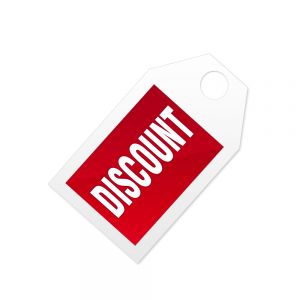Have you ever walked in to a store intending to buy one or two things and then walked out with five other items? Have you ever gotten home, looked at your purchases, and wondered what you were thinking? Chances are pretty high that you’ve fallen for some old retailing tricks that subtly encourage you to purchase much more than you planned to.
![]() Just what are those “tricks,” you ask? Here are eight of the most popular retail pricing and promotion strategies designed to get people to part with their money. The next time you go shopping in a retail store or order a meal out, see how many of these strategies you can spot:
Just what are those “tricks,” you ask? Here are eight of the most popular retail pricing and promotion strategies designed to get people to part with their money. The next time you go shopping in a retail store or order a meal out, see how many of these strategies you can spot:
1. Prices that end in 9, 99, or 95
Ever wonder why so many items end in 99 cents? Do the stores really think that a penny will tip the scales of a purchasing decision? Well, actually they do. Known as “charm prices,” prices ending in 9, 99, or 95 make items appear cheaper than they really are. Since people in the Western world read from left to right, they are more likely to register the first number and make an instant decision as to whether the price is reasonable.
2. Prices without dollar signs
Ever been to a restaurant that leaves the dollar signs off its menus? They’re trying to make you spend more. In a Cornell study, the guests who were given a menu with only numbers and no dollar signs spent significantly more than those who received a menu with either prices showing a dollar sign or prices written out in words. Like the strategy above, retailers are hoping customers won’t associated the stated number with money, and thus will be more comfortable running up a larger tab.
3. Dollars without cents
If you ever see a price tag or a menu where then prices are in rounded dollars, the retailer or restauranteur is sending the message that you’re in a high-end place. They are trying to imply: if you’re concerned about pocket change, then this isn’t the purchase for you.
4. The bulk sales trick
Stores often advertise deals like buy 10 items for $10 or 5 for $20. The goal is to get shoppers to buy the full number of items stated in the sale. These days, many shoppers may psychologically feel better about a purchase if they buy in bulk, because they may feel like they just maximized their savings. But if you know that you really don’t need those 10 items, then realize that often you don’t have to buy in bulk to get the deal.
5. Per-customer limits
When stores add limits to product promotions, like “limit 5 per customer,” they are tapping into some pretty powerful psychological motivators. People will be more likely to act when they feel a desired product is scarce and the deal is exceptionally good. Many shoppers fall for this one and end up buying several items instead of just buying the one that’s needed.
6. The “free” promotion
Who doesn’t like free things? Retailers know that these days in particular “free” is the magic word. Those buy-one-get-one-free deals, free gifts with purchase, or even free shipping can sometimes be pretty irresistible and we can end up buying things we didn’t plan on purchasing.
7. Simple prices
In a strategy that differs a bit from the prices that end in 9’s or 5’s, retailers sometimes put simple prices on products that will likely be marked down in the future so that shoppers can quickly calculate how much they’re saving. It’s easy to compute the discount on a product originally priced at $60 that now costs $40, rather than an item originally priced at $59.99, now on sale for $37.99.
8. Price Font Size
This one seems a bit counter-intuitive. Marketing professors at Clark University and The University of Connecticut found that consumers perceive sale prices to be a better value when the price is written in a small font as opposed to large, bold typeface. The reason: the larger the font, the bigger the price seems!
